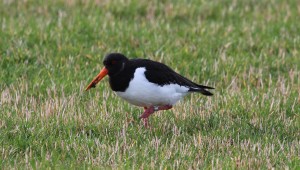 The birds that signify spring can vary with many people listening for the first cuckoo, scanning pussy willows for the first warblers, or even the ospreys returning from Africa. Each have their own appeal but there are now two large waders that to many epitomise spring as the birds move back into straths and glens. These are the conspicuous black and white oystercatcher and, in contrast, the well camouflaged curlew. Both by now will have returned to their breeding sites of last summer and their calls can be heard during the day and, unusually for birds, during the hours of darkness. The shrill piping calls of the oystercatchers are unmistakable as are the plaintive “cour-lee” call of the curlew. However the curlew has a variation to its calls in that in the spring courtship it also has a lonely sounding, bubbling trill.
The birds that signify spring can vary with many people listening for the first cuckoo, scanning pussy willows for the first warblers, or even the ospreys returning from Africa. Each have their own appeal but there are now two large waders that to many epitomise spring as the birds move back into straths and glens. These are the conspicuous black and white oystercatcher and, in contrast, the well camouflaged curlew. Both by now will have returned to their breeding sites of last summer and their calls can be heard during the day and, unusually for birds, during the hours of darkness. The shrill piping calls of the oystercatchers are unmistakable as are the plaintive “cour-lee” call of the curlew. However the curlew has a variation to its calls in that in the spring courtship it also has a lonely sounding, bubbling trill.
The oystercatcher has had to react to adverse changes in the countryside as far as suitable breeding sites are concerned. At one time it was almost restricted to the coast, nesting on pebbly beaches above the tide-line but disturbance and predation made them adapt to more inland sites. They will now breed on fields and moorland or on sides of rivers such as the River Findhorn south of Inverness. However, perhaps the greatest change for them has been habitation. For example many pairs nest on the flat roofs of buildings such as the school at the Royal Academy in Inverness. However, at the school they are predated upon by gulls and crows. Another unusual site was a few years ago when one nested in the car park of the busy Dingwall Mart and the female could be seen incubating her eggs whilst the cars parked all around her!
One of the reasons that the oystercatchers managed to breed on the flat roofs of buildings is that they are very unusual in the wader family in that the young do not feed themselves. In all other waders the chicks are virtually able to feed themselves as soon as they hatch but not so the oystercatchers. Otherwise the young on a roof would starve as there is nothing there for them to eat. So the adult males and females bring the young all their food until the chicks are fledged. The chicks, as with most other waders, have a defence mechanisms as they have a pale line of feathers around their necks. This means that from above the chick looks like two round pebbles and this has fooled many predators.
As with other waders, part of the oystercatchers’ success is that they live a long time. The oldest curlew, for example, was recorded as over 31 years, whilst oystercatchers have lived for at least 43 years although with both species the average life-span is much shorter. These ages are confirmed by ringing, such as the oystercatcher in the photograph. A few years ago an oystercatcher was brought to me having been found freshly dead in Strathnairn just south of Inverness. The bird was, fortunately, ringed so we were able to say something about its remarkable history. The bird was hatched in 1976 and first ringed in Inverness in 1978. In 1991 it was re-trapped a few miles east of Inverness and, as the ring was very worn, it was replaced. So when it died it was 28 year old which is quite remarkable and you can only imagine what that bird had experienced. At the end it had succumbed to being hit by a vehicle on the road, an ignominious end to such an oystercatcher!
Tags: highland wildlife
